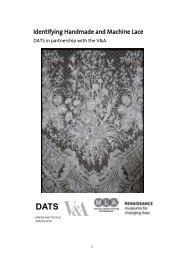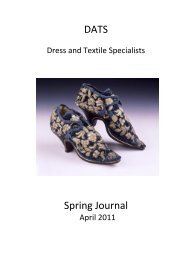Spring 2012 - Dress and Textile Specialists
Spring 2012 - Dress and Textile Specialists
Spring 2012 - Dress and Textile Specialists
You also want an ePaper? Increase the reach of your titles
YUMPU automatically turns print PDFs into web optimized ePapers that Google loves.
on making sure that people can see the actual objects; moreover, that we can listen <strong>and</strong> talk to<br />
visitors to make sure that we underst<strong>and</strong> their needs, <strong>and</strong> can respond to them.<br />
Our paper will explore this practise by showcasing principally, three areas of our current endeavour.<br />
First, our displays, particularly, Behind the Scenes: The Historic Collection where our collections of<br />
19th century dress are presented as if visitors were entering the museum store. Secondly, <strong>and</strong><br />
leading on from this, storage of our collections <strong>and</strong> the way in which we are making our stores<br />
accessible. Thirdly, we will discuss the development of the Fashion Museum Study Facilities, which<br />
are currently visited by over 1,200 people each year.<br />
Background to the collection<br />
One of the reasons we were so keen to attend the DATS conference this year was to achieve our aim<br />
of spreading the word about the Fashion Museum <strong>and</strong> introducing as many people as possible to the<br />
collection. The Fashion Museum is housed in the historic Assembly Rooms on Bennett Street. For<br />
centuries Bath has been a centre of fashion, attracting visitors to its spa <strong>and</strong> social diversions. The<br />
Assembly Rooms is one of Bath’s finest Georgian buildings <strong>and</strong> is still central to the city’s social life<br />
today.<br />
Bath's magnificent 18th century Assembly Rooms were opened in 1771. Designed by John Wood the<br />
Younger, they were known as the New or Upper Rooms, to distinguish them from the older<br />
Assembly Rooms in the lower part of the town. An ‘assembly’ was defined in 1751 as ‘a stated <strong>and</strong><br />
general meeting of the polite persons of both sexes, for the sake of conversation, gallantry, news<br />
<strong>and</strong> play’, which basically meant that guests amused themselves at cards, danced in the ballroom,<br />
drank tea or just walked around talking <strong>and</strong> flirting.<br />
The Fashion Museum came to Bath as the Museum of Costume in 1963. It was founded by Doris<br />
Langley Moore, an inspired collector, writer, historian <strong>and</strong> costume designer who was passionate<br />
about fashions of the past <strong>and</strong> who generously gave her private collection of historic dress to the<br />
city of Bath. The Museum of Costume actually found its first home in 1955 at Eridge Castle in Kent, a<br />
little outside London. At Eridge Castle, Doris Langley Moore established her particular style of<br />
costume display, which was to display her collection on ‘realistic’ mannequins.<br />
Doris Langley Moore believed that you needed to underst<strong>and</strong> the context of the dress, something<br />
that we still strive for today at the Fashion Museum, albeit in different ways. In the mid-1950s<br />
however, this was not the usual approach to the display of dress within a museum, where more<br />
often than not, dress was viewed solely as a textile <strong>and</strong> as a branch of the decorative arts. The<br />
Museum of Costume remained at Eridge Castle for three years, <strong>and</strong> in 1958 was transferred to the<br />
Royal Pavilion in Brighton for a special exhibition. But eventually in 1963, the Museum of Costume<br />
found its permanent home in the newly re-opened Assembly Rooms in Bath.<br />
The museum was called the Museum of Costume, Bath until the name change in 2007. It was a big<br />
decision to change the name of the museum <strong>and</strong> one we only undertook following careful audience<br />
evaluation <strong>and</strong> testing. The feeling was that ‘Fashion’ rather than ‘Costume’ was a better fit with the<br />
museum collection <strong>and</strong> with visitor expectation; <strong>and</strong> it has been a seamless <strong>and</strong> successful<br />
adjustment in our identity.<br />
The Fashion Museum galleries are on the lower ground floor of the Assembly Rooms. The displays<br />
are arranged (by <strong>and</strong> large, chronologically) in a series of non-uniform showcases following a<br />
labyrinthine route. There are currently just over 180 figures on display, plus displays of accessories.<br />
There are also feature areas within the museum galleries that present dress thematically. For<br />
example in 2011, we have a display of wedding dress, <strong>and</strong> in <strong>2012</strong>, the year of the Olympics, there<br />
will be a display of fashion <strong>and</strong> sportswear.<br />
12





